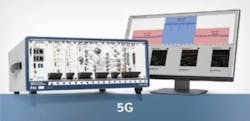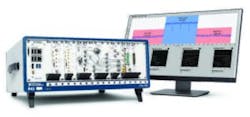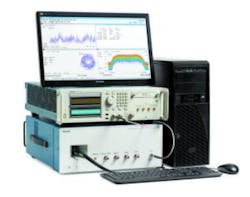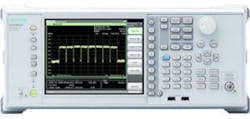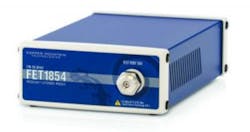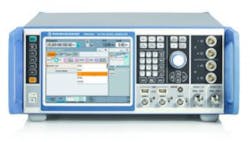The transition from 4G to 5G is progressing, with prototyping and field trials underway even as network operators wrestle with the business case for the new technology while 4G has plenty of life left. Nevertheless, progress is accelerating in areas ranging from simulation and modeling to over-the-air (OTA) testing. Participants in the 5G ecosystem are working to reduce latency, to increase data rates, and—of course—to control costs.
Cooperation among 5G ecosystem members will be critical. “Moving technology forward and ensuring the successful rollout of 5G must be a collaborative effort; companies cannot operate in silos,” said Adnan Khan, senior business development manager at Anritsu Co.
“With that in mind, Anritsu has worked with research institutes worldwide as well as with fellow global 5G leaders to conduct research and develop solutions.”
He noted that Samsung, for example, has been using Anritsu equipment and software to support its 5G system-development efforts. In addition, he said, “Anritsu is also working with Qualcomm Technologies and other chipset vendors to support test development for devices such as baseband chips.” Anritsu’s test platform for 5G, he added, supports Qualcomm in its efforts to commercialize next-generation 5G New Radio (NR) technologies.
Will Sitch, director of industry and solutions marketing at Keysight Technologies Inc., commented on the many challenges associated with 5G. “The technological leap from 4G to 5G is a huge step, and some aspects—like 1-ms latency requirements for some applications—are going to be difficult to implement in a commercial network,” he noted. “That said, much of the 5G technology developments are currently being prototyped and are even undergoing live traffic trials, and Keysight is very involved in this process.”
Another challenge relates to the 5G business model. Sitch noted that at the Mobile World Congress in Barcelona in February, Korea Telecom was quite vocal in expressing uncertainty regarding the 5G business case. Sitch quoted YongGyoo Lee, head of its 5G business unit, as having said, “It’s not clear what the business case is, not clear at all.”1
Sitch pointed out that the cost per bit on a 5G network may not make sense for some operators. “Indeed, 4G LTE Advanced Pro still has legs,” he said. With carrier aggregation, more complex 256QAM modulation, and LAA utilization of unlicensed bands, we’ve seen real-world demonstrations of more than 1-Gb/s data transfer to a 4G device on a 4G network.”
Lauri Viitas, VP of product and business development Guzik Technical Enterprises, commented, “Cost of test is critical for 5G systems due to the large number of devices required by the short-range mesh network. Manufacturing test solutions must be small, scalable, ultrafast, and repeatable. Speed is particularly important, as higher speeds lead directly to a lower cost of test. Due to the multi-element antennas used for beamforming, phase linearity and accuracy across wide bandwidths become critical as well.” Guzik, he said, focuses on 5G signal analysis and OTA testing of end devices and subsystems in the both in R&D and in manufacturing.
The many challenges associated with 5G relate to mmWave frequencies, wider bandwidth, lower latency, greater flexibility, and virtualized (core-network) functions, according to Andreas Roessler, 5G technology manager at Rohde & Schwarz. “From our perspective, the biggest challenge to address in the remainder of 2018 is to get an official 5G standard in place,” he said. “Taking a closer look at the officially released specifications reveals that there are still many important points open and undecided. This holds true for the first version of the specification released in December 2017 that focuses on L1/L2 parameters and eMBB as a use case.”He noted that standardization work is underway in the specification groups RAN4 and RAN5 that are responsible for testing aspects, in particular related to OTA testing of wireless devices supporting mmWave frequencies. “The challenge here is to have the industry agree on final test methodologies and procedures that will be used,” he said, citing actual metrics and key performance indicators to measure 5G devices and to provide an accurate test-case definition for RF and performance test cases and Radio Resource Management (RRM).
“The apparent truth is that our industry is not as far along as some would want to believe, thus sending the wrong message that may result in additional problems and delays,” he said. “The question that needs to be asked is why the rush? Granted, new 5G applications and devices will, no doubt, generate new revenue—but at the same time, many of the proposed use cases for 5G can be effectively accomplished using existing technology today”—including Gigabit LTE. “Research backed with adequate modeling and simulations takes time to do, to discuss, and to incorporate into the standards,” he said. “As an industry, we need to get it right, since this is the first time in our industry that so many other industries will be impacted—for example, automotive, critical communications, medical, transportation, and agriculture, to name a few.”
Khan at Anritsu also commented on test methodology. “The first version of the 5G NR standard has been completed; however, there are no approved tests included in the specification,” he said. “Test methodologies must still be developed. Until then, verification parameters may vary between chipset manufacturers, device makers, and operators.”
Khan added, “Perhaps the biggest issue, however, is economics. 5G components, devices, and systems must all be developed at an efficient price point, which places a great deal of pressure on keeping cost-of-test low. This is particularly difficult for a few reasons. First, the adoption of mmWave technologies in 5G inherently increases the cost of test, due to complexities associated with higher frequencies.”
Khan continued, “Another key cost variable is OTA testing, which is necessary because it will be impossible to separate the antenna from the other components in a 5G device. Without approved test standards, chipset and device manufacturers will have to develop custom modulations and OTA chambers. Additionally, the lack of ratified test standards means there is no consensus as to how many test points are required for OTA tests. There must be a balance between ‘as few as possible’ to control costs yet enough to have a high degree of design confidence.”
From R&D to production
As for his company’s strategy, Khan said, “Anritsu provides test solutions that can be used during different phases of testing, transcending from R&D to production, to ensure optimal operation of components and systems in accordance with the recently approved 5G New Radio (NR) standard. We have developed test instruments to efficiently and accurately measure mmWave 5G components, including antennas, as well as devices in OTA environments. To ensure the proper deployment and operation of fiber cables in end-to-end (E2E) scenarios, Anritsu has enhanced its optical test solutions.”
Sarah Yost, senior product manager, National Instruments, commented that test and measurement will be key to the 5G commercialization cycle. “Test systems must expand beyond the physical layer to quickly and cost-efficiently test these new multiantenna technologies with controllable/steerable beams,” she said. “Additionally, these systems must address the new mmWave-capable devices with extremely wide bandwidths. These test solutions must not only be able to test the important parameters of a device but also be cost-effective for 5G to reach its potential and achieve widespread adoption.”
Consequently, she said, 5G requires a different approach for wireless-device and system test. “For example, system-level OTA test must become standard in the 5G ecosystem,” she noted. “OTA test presents several challenges, but perhaps the most daunting pertains to the environment in which the test equipment and the device under test must coexist. Air is an unpredictable medium, and the channel itself varies over time and environmental conditions. Wireless test engineers must isolate the channel in the OTA scenario and control the device on a per-beam basis to effectively ‘test’ the device.”
She also noted that companies including Intel have introduced early phased-array antenna modules featuring an antenna attached directly to the RF front end to minimize system losses. “Because access to the device is limited, the test equipment must step up in frequency to the mmWave bands and characterize key performance metrics beam-by-beam,” she said.
“Finally, whereas bandwidth is a familiar test challenge, the tested bandwidth of 5G is expected to increase by 50X over a standard LTE channel,” Yost said. “At these bandwidths, test systems must not only generate and acquire wider bandwidth waveforms but also process all that data in real time.”
Ken Karnofsky, senior strategist, signal processing and communications at MathWorks, emphasized software’s role in 5G. “With the completion of the 3GPP Release 15 standard, the primary challenges are shifting from research problems to implementation and verification challenges,” he said. “For companies seeking to deploy 5G products quickly, that means having a reliable software golden reference that can be used to verify designs in advance of lab or field testing to avoid costly bugs and project delays. This is particularly needed to ensure that the flexible frame structures and other physical-layer changes in 5G are implemented correctly.”
Karnofsky noted that the higher frequencies and wider bandwidths in 5G are causing major changes to baseband and radio architectures. “For example, massive MIMO antenna arrays for mmWave will require hybrid beamforming partitioned across digital and RF domains, and advanced DSP techniques are needed to linearize power amplifiers across wide bandwidths,” he said. “Both technologies require joint design of digital and RF subsystems, which can be difficult for engineers trained in one field or the other.”
Karnofsky cited several capabilities MathWorks introduced in late 2017 and early 2018 for 5G applications:
- 3GPP Release 15 physical-layer specifications, including flexible carrier spacing and frame numerology, LDPC channel coding, and polar codes;
- nonlinear power-amplifier modeling from measured data and closed-loop simulation of PAs with linearization techniques such as digital pre-distortion (DPD);
- map-based visualization and analysis of RF propagation, signal coverage, and SINR; and
- algorithms and reference designs for FPGA and ASIC implementation of LTE subsystems.
“MATLAB is used by many wireless engineers to rapidly develop and prove out algorithms and design concepts,” he said. “Together with Simulink, it provides an environment that supports development of standard-compliant systems, design of hybrid digital/RF subsystems, and hardware-independent testing and prototyping.”
Software and modular hardware
National Instruments emphasizes software in conjunction with hardware. “NI has long believed that the future of test and measurement lies in a software-defined approach, as evidenced by our continued investment in our modular hardware platforms like PXI and LabVIEW system design software,” Yost said. “We have had that philosophy for well over 30 years now—it is in our DNA. Customers are already using PXI and LabVIEW to prototype possible 5G implementations today, and our engagement with industry leaders in 5G prototyping has given us valuable insight into this evolving standard. A specific example of this is LabVIEW Communications, which has helped wireless researchers advance the pace of 5G development.”
National Instruments’ recently introduced products for 5G including a sub-6 GHz-5G test reference solution (Figure 1) compliant with the 3GPP Release 15 specification for 5G NR, demonstrated at the Mobile World Congress. “With commercial 5G NR deployments below 6 GHz on the horizon, engineers are actively developing sub-6 GHz-5G RF components and devices,” Yost said. “The accelerated pace of 5G standardization is driving intense pressure to bring products to market quickly. NI’s sub-6-GHz 5G NR reference solution is a cost-effective and high-performance option for test that helps engineers quickly characterize their RFIC designs and more easily transition from R&D to production test environments.”
Tektronix focuses on the evolution of front- and backhaul fiber technology in 4G and 5G networks, according to Mark Elo, technical marketing manager, adding that scaling the network, understanding performance, and driving issues to root cause will be one of the biggest challenges as network operators move through the test market phase and on to large-scale deployments.
As for the company’s product strategy, “Tektronix oscilloscopes with optical input adaptors provide high performance capability for product design and verification of network products as well as key network performance validation tools for network operator R&D labs when validating 5G equipment,” he said. For coherent optical formats, the company offers the DPO77002SX 70-GHz oscilloscope along with the OM4245 optical modulation receiver. For NRZ & PAM4-based optical formats, the DSA8300 sampling scope mainframe with the 80C17/18 optical sampling modules provide high-sensitivity, low-noise optical measurement capability suitable for 28-Gbaud ORR-compliant measurement evaluation. He added that the DPO77002SX 70-GHz scope with SignalVu software supports mmWave 5G wireless signal transmitter test in the lab.
In addition, Elo said, “5G networks will also heavily use LTE bands, where interference is the largest problem—Tektronix commitment to real-time capability in spectrum analysis with the RSA300/500 RSA utilizing DPX technology gives the network-maintenance technician the insight to find and trace to root cause the most elusive interfering signals. Its USB interface allows for easy connection to popular handheld/portable Windows-based-field test tools.”
Finally, Elo said, “The RSA7100A wideband signal analyzer with an industry leading 800-MHz real-time bandwidth (with external mixer) allows network RF performance evaluators to record spectral performance to a hard-disk array. The RSA7100A can trigger on and measure signals of just 700 ns duration in the frequency domain in real time while offering in-depth RF and modulation signal analysis with SignalVu software” (Figure 2).
Khan at Anritsu cited specific products the company offers for 5G test. “Our most recent 5G test solution is the Radio Communication Test Station MT8000A, which is unique in that it is a single instrument capable of performing RF and protocol tests on 5G chipsets and terminals,” he said. “With a 5G base-station emulation function, a single MT8000A test platform supports both the sub-6-GHz and mmWave bands used in 5G. Combining it with an OTA chamber enables mmWave-band RF measurements and beamforming tests based on the 3GPP protocol stack.”
Khan continued, “The modular architecture of the MT8000A supports current high-speed broadband communications, while also providing flexible futureproof support for new 5G test requirements, including URLLC (Ultra-Reliable and Low Latency Communications) and mMTC (massive Machine Type Communications).” He said a single chassis can accommodate multiple test cards that can be easily added as test requirements change and standards evolve.
Anritsu has also developed 5G measurement software for its MS2850A spectrum/signal analyzer (Figure 3) that is compliant with 5G NR, Khan said. “Specifically developed for the design and manufacture of 5G NR radio equipment, the software options support analyses of uplink and downlink signals used by the sub-6-GHz frequencies as well as mmWave bands, such as 28 GHz and 39 GHz, in the 5G NR standard,” he added. “With the software installed, the MS2850A allows engineers to specify combinations of multiple component carriers up to 400 MHz and subcarrier intervals. Fast and stable signal-analysis measurements of key parameters, such as Tx power, frequency error, and EVM, are supported by the MS2850A, as well.” He added that a key spec is the instrument’s 142-dB dynamic range.
Copper Mountain Technologies is targeting 5G test with its lineup of metrology-grade VNAs, according to CEO Irena Goloschokin. “Our CobaltFx Series allows engineers to build a scalable and cost-effective 5G testing solution offering industry-leading dynamic range and sweep speeds, utilizing frequency extension to create dedicated test solutions for various 5G bands: 18 to 54 GHz, 50 to 75 GHz, 60 to 90 GHz, and 75 to 110 GHz,” she said.
In March, the company launched the FET 1854 frequency extender (Figure 4), which completes the lineup for CobaltFx mmWave frequency extension solution up to 110 GHz. A dedicated coaxial band covers 18 to 54 GHz; waveguide bands include 50 to 75 GHz, 60 to 90 GHz, and 75 to 110 GHz, which can be anchored by a 9-GHz or 20-GHz VNA.
In addition, “We are launching RVNAX16 software to allow simultaneous testing of up to 16 antennas using Copper Mountain Technologies 1-Port VNAs (reflectometers), Goloschokin said. “For 5G it is common to package a number of antennas in a single package,” adding that the software will make the development and production testing of 5G antenna arrays cost-effective and scalable.
AXIe digitizer
Guzik’s product strategy centers on its recently introduced ADP7000 Series digitizers, which combine processing power with a proprietary Keysight 10-bit ADC into a single slot AXIe modular form factor.
“This ADC, which is unavailable on the open market, allows direct sampling of RF signals up to 32 GS/s on two channels simultaneously from DC to 10 GHz with 10-bit resolution,” Viitas said. “Multiple ADP7000 modules can be combined to increase the number of phase-coherent channels. The digitized data is routed to four Intel FPGAs which include 13,504 multipliers and deliver a combined processing power of 6 TFLOPS.”
Commenting on Keysight’s products, Sitch said, “With the recent acquisition of Ixia, Keysight now has a comprehensive suite of 5G design, test, measurement, optimization, and visualization tools that span the network stack from the physical layer to the application layer. These hardware and software solutions are augmented by the experience we’ve gathered through our early partnerships with industry leaders.”
Keysight has recently announced solutions for the various participants in the 5G ecosystem. For example, for chipset and device manufacturers, “We announced our new 5G mmWave OTA performance test solution and demonstrated the industry’s first 5G 4Gb/s data throughput connection at 28 GHz,” Sitch said. “This solution uses our new 5G NR signal creation and analysis software tools.”
He said Keysight also has demonstrated its 5G NR-ready end-to-end device workflow solutions, which streamline chipset and device product workflow from early prototyping and development to design validation and manufacturing. In addition, the company demonstrated its 5G nonsignaling mmWave transceiver solution, which covers the 28-GHz and 39-GHz frequency bands. “This new cost-effective solution enables device manufacturers to perform 5G mmWave device validation and ramp early production,” he said.
For network equipment manufacturers, “We demonstrated our new UE Emulation (UEE) solution with Samsung, showing successful interoperability testing with the UEE solution and Samsung’s new 5G NR base station,” Sitch said, adding, “We demonstrated our unique 5G NR-ready testbed, designed to deliver wideband flexible signal generation and analysis for design validation test of complex 5G NR waveforms in coexistence scenarios with 4G LTE signals.” In addition, he said, “Our newly-released 89600 VSA option BHN for 5G NR modulation analysis offers in-depth physical-layer testing and troubleshooting of NR base station transmitters and components.”
For mobile network operators, Sitch said, “We demonstrated our 5G Packet Core (NGC) Live Testing solution, the industry’s first 5G packet core high-scale network test solution.” The company also demonstrated its Nemo Wireless Network Solutions, which include Nemo Outdoor for making cellular-IoT field measurements in live networks (enabling mobile operators to verify NB-IoT and LTE-M coverage as well as optimize network quality to ensure customer satisfaction) and the Nemo Xynergy data-analytics solution.
Roessler at Rohde & Schwarz commented that his company’s vision is to enable customers to bring to market 5G products in the most timely, cost-efficient and responsible manner possible. “As the leader in T&M equipment for the 4G technology turn, we realize that 5G is both an evolution and a revolution,” he said. “The evolutionary aspects of 5G build upon our strong product portfolio and technology leadership supporting key measurement capabilities closely aligned with 3GPP, with a proven track record testing those technologies that will lay the foundation for 5G”—including carrier aggregation, MIMO, and OTA testing. “The revolutionary aspects of 5G in which existing and new technologies will be pushed to their physical limits require a technology leader that is willing to take a step back and reevaluate how T&M will change with the coming of 5G, and then invest in the right products and people to deliver the solutions that the market needs,” he continued.
“The latest addition to the Rohde & Schwarz 5G test and measurement product portfolio was the official release of our 5G NR signal generation and signal analysis option for our industry leading R&S SMW200A vector signal generator (Figure 5) and FSW signal and spectrum analyzer,” Roessler said. “To date, the SMW200A is the only single instrument in the market that provides internal 2-GHz modulation bandwidth up to an RF frequency of 40 GHz.” He added that the R&S FSW can support frequencies up to 90 GHz in a single instrument. If used with a digital oscilloscope like the R&S RTO2064, the analysis bandwidth can be further increased from 2 to 5 GHz. The goal, he said, is an investment in future-proof solutions for all the upcoming challenges in 5G and other areas, including, for example, automotive radar.
Looking ahead
Looking ahead, Sitch at Keysight said, “I think 5G deployments will start in 2018, but initially these will probably be fixed wireless broadband rather than mmWave mobility. In 2019 I think we’ll see 5G devices working in 5G non-standalone (NSA) networks (which rely on a 4G network that can support 5G devices) delivering higher data rates to mobile UEs in the sub-6GHz bands.”
He concluded, “I know there’s a lot of research and development around mmWave mobility, and I’m very excited about the technology, but I don’t know if the line-of-sight limitations of mmWave communications can work in a dense urban environment. I’m not a great prognosticator and I have no idea what will be happening in 2020, but I can’t wait to be part of it!” EE
References
1. Wieland, Ken, “KT unclear on 5G business case,” Mobile World Live, Feb. 28, 2018.
For more information:
Anritsu
Copper Mountain Technologies
Guzik Technical Enterprises
Keysight
Mathworks
National Instruments
Rohde & Schwarz
Tektronix
About the Author

Rick Nelson
Contributing Editor
Rick is currently Contributing Technical Editor. He was Executive Editor for EE in 2011-2018. Previously he served on several publications, including EDN and Vision Systems Design, and has received awards for signed editorials from the American Society of Business Publication Editors. He began as a design engineer at General Electric and Litton Industries and earned a BSEE degree from Penn State.
